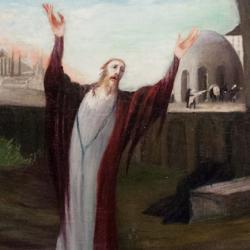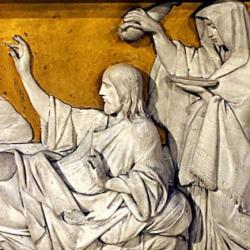In my sermon notes from last week, I took the position that Jesus makes a transition in verse 14 to talking about a final judgment, and the time between Jesus’ ascension and the end of this creation. Two details hint that Jesus has changed theme.
First, 25:13 matches 24:42, and thus closes out the section about the “day and hour” that is coming within “this generation.” Second, the master in this parable is gone for a “long time” (v. 19). Jesus thus appears to be talking about the whole age between the ascension and the final judgment.
After further reflection and discussion, I’m not so convinced of that reading and am leaning in the opposite direction.
The structural consideration is not as weighty as I thought. There is an inclusio between 25:13 and 24:42, but there’s also an inclusion in 24:51 and 25:30. Both of those verses speak of a place where worthless, rebellious slaves are sent, where there is “weeping and gnashing of teeth.” That suggests that the parable of the household slaves is linked to the parable of the slaves with the talents, and that hints that it’s talking about the same subject. Also, it links the parable of the virgins to the parable of the talents, and if the first is about the time before AD 70, the second should be as well.
The “long time” could be a description of the forty years between Jesus’ ascension and the destruction of Jerusalem . Forty years, as I emphasized last week, is a long time. A great deal can happen, and when something that you eagerly await is delayed for forty years, it is a very long time.
Also, verse 14 doesn’t seem to provide enough of a transition. 25:1 compares the kingdom of heaven to virgins with their lamps awaiting the coming of the bridegroom; the “kingdom of heaven will be comparable to ten virgins.” 25:14, which introduces the next parable with “for just like a man to go on a journey,” and that seems as if he’s illustrating the same event with a different parable.
As I suggest in my sermon notes this week, if we take Matthew 25 as a whole to be a prophecy of the coming of the Son of Man at the end of the first generation of the church, then the Olivet Discourse moves nicely from a discussion of the judgment of Jerusalem, to three parabolic exhortations to the disciples to be prepared for Jesus’ arrival, to a judgment on the nations (v. 32). I’m not entirely sure what that means, but it appears to be linked to the nations’ treatment of the disciples, the “least of these my brothers,” who are sent out to the nations (28:18-20).
Several verses in Matthew 25 create difficulties for this reading. One is v. 34, which speaks of inheriting a kingdom prepared from the foundation of the world. Another is 25:46, which is speaking of the eternal destiny of sheep and goats. How is that happening in AD 70? How do nations go into everlast life or death anyway? I don’t know; perhaps, like prophecies in the Old Testament, this judgment scene telescopes two time periods, the judgment of the nations in AD 70 and the final judgment.















